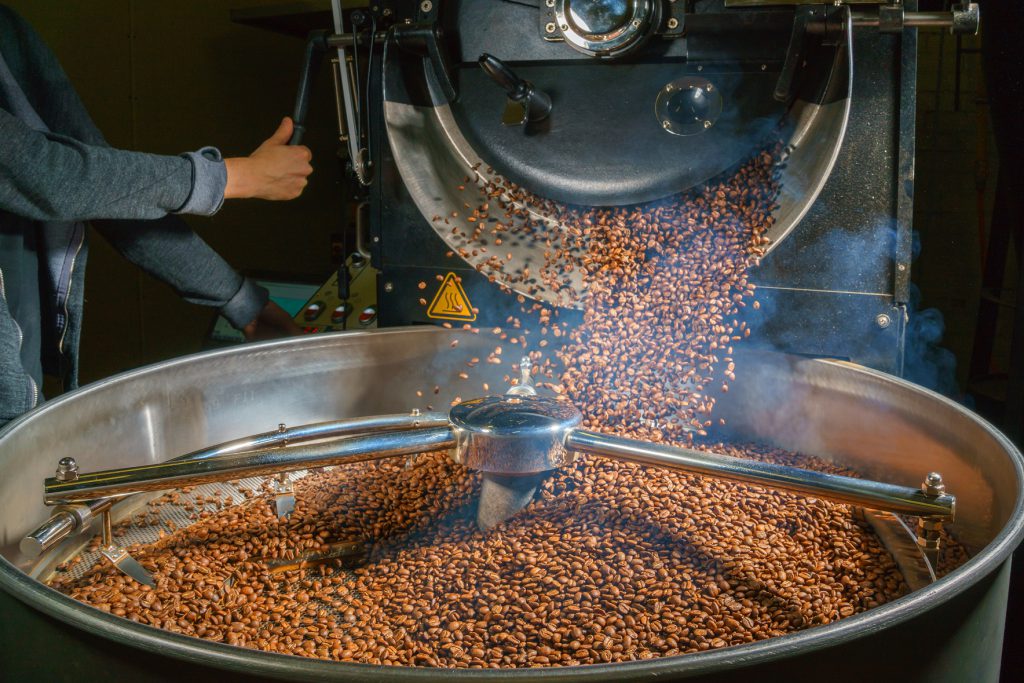
Diacetyl Exposure in Coffee Processing Operations

Written by: Brittiny Harris, NES, Inc.
 Diacetyl exposure in coffee processing presents a health hazard for employees.
Diacetyl exposure in coffee processing presents a health hazard for employees.
Diacetyl Exposure in Coffee Roasting and Packaging Facilities
The U.S. Department of Health and Human Services Centers for Disease Control (CDC) and the National Institute for Occupational Safety and Health (NIOSH) recently released findings regarding potentially dangerous diacetyl exposure in coffee processing operations. The findings were published jointly in a report entitled Evaluation of Exposures and Respiratory Health at a Coffee Roasting and Packaging Facility. The main message behind the report is that harmful chemicals including diacetyl and 2,3-pentanedione are released into the air during the processes of roasting, packaging, stirring, and moving coffee beans. Without the proper control measures in place, employee exposure to these toxic chemicals can reach dangerous levels.
Testing for Diacetyl Exposure in Coffee Facility Operations
The Health Hazard Evaluation Program of NIOSH visited Just Coffee Cooperative, a coffee roasting and packaging facility in Madison, Wisconsin, to test employee exposure to harmful chemicals. NIOSH collected air samples for dust and volatile organic compounds (VOCs). The VOCs that were being measured consisted of diacetyl, 2,3-pentanedione, and 2,3-hexanedione, all of which are chemicals harmful to human lungs known as alpha-diketones.
Alpha-Diketones
Alpha-diketones are molecules that contain two ketone groups. These are organic compounds that contain carbon, which, in certain forms, can be bad for the lungs and heart (learn more about the environmental and health effects of carbon here). Alpha-diketones are added to food flavorings such as microwaveable popcorn, bakery mixes, and coffee. In the case of NIOSH’s findings at the coffee roasting facility, diacetyl and 2,3-pentanedione were the two main VOCs detected. These chemicals are released during the coffee roasting process, which involves coffee bean stirring (sometimes by hand), heating, flavoring, and packaging/shipping. Each part of the process leads to employees breathing in the toxic chemicals emanating from the coffee. Many coffee roasting facilities package their newly roasted coffee in bags that are fitted with one-way valves in order to allow the coffee to off-gas after it has been packaged and before it is shipped.
 Diacetyl is harmful to human lungs if inhaled regularly at amounts above a certain threshold or if acute exposure occurs for a shorter duration.
Diacetyl is harmful to human lungs if inhaled regularly at amounts above a certain threshold or if acute exposure occurs for a shorter duration.
Diacetyl Exposure in Coffee Processing: Analyzing the Results
NIOSH was able to visit the facility twice, once in July of 2015 and once in March of 2016. Both times it was found that there were harmful chemicals being released into the air at levels greater than NIOSH advises for human health. The three major sources that were identified as contributing to elevated diacetyl and 2,3-pentanedione inhalation risks consisted of the flavoring chemicals added to the roasted coffee beans, the grinding of unflavored coffee beans, and the storing of roasted coffee beans in order to let them off-gas.
Because NIOSH representatives performed testing both in a summer month and in a winter month, the study was able to point out that in the winter month the coffee roasting facility was a more dangerous environment than when NIOSH came back a little over half a year later and tested the facility during the summer. The factor that changed the levels of diacetyl and 2,3-pentanedione was air ventilation. In the winter, due to the uncomfortably cold weather found in Madison, Wisconsin, the bay doors remained closed. However, during the summer the bay doors were propped open, creating a natural ventilation system to help air out the toxic chemicals radiating from the coffee beans and coffee roasting machinery.
Recommended Exposure Limits
Upon discovering the presence of diacetyl and other toxic chemicals in coffee roasting facilities, NIOSH established recommended exposure limits (RELs) to help employers create a safer environment for their employees. The main RELs established for diacetyl exposure in coffee processing limit levels to 5 parts per billion (ppb) as a daily time-weighted average (TWA) and no more than 25 ppb in any 15-minute period. The hope of these RELs is to reduce, if not eliminate, the risk of respiratory impairment in coffee roasting facility workers. NIOSH believes that through following the recommended guidelines, fewer than 1 in 1,000 workers will develop reduced lung functions based on an 8-hour day / 40-hour week / 45-year working experience.
Respiratory Impairment and Coffee Facility Employees
Respiratory impairment refers to coughing, shortness of breath, wheezing, and fatigue. These are all symptoms of a serious health condition tied to diacetyl exposure called obliterative bronchiolitis. Exposure to harsh chemicals can cause scarring of the bronchioles (the smallest airways in the lungs), making it impossible to completely fill the lungs with air. When the bronchioles are scarred, they are no longer able to inflate, effectively reducing an individual’s lung capacity. Unfortunately, once an individual’s bronchioles are affected in this way, they never heal.
Click here to learn more about flavorings-related respiratory impairments.
 Coffee processing operations can stir up diacetyl and other hazardous chemicals, creating an inhalation hazard for employees.
Coffee processing operations can stir up diacetyl and other hazardous chemicals, creating an inhalation hazard for employees.
Mitigating Employee Diacetyl Exposure in Coffee Facilities
Due to these findings by NIOSH, employees who work in coffee roasting facilities are advised to take caution in their everyday work tasks. Ultimately, this responsibility falls to the employer. NIOSH has created a list of recommendations for how to mitigate or eliminate diacetyl exposure in coffee processing. To make the work environment safer for employees, NIOSH provides suggestions for modifying the machinery to make it safer, creating ventilation through the facility, changing the ways employees work with the coffee beans, and quite a few more solutions to this recently discovered occupational health and safety concern.
NIOSH encourages coffee roasting facilities to create a group of dedicated individuals to get together and decide on a plan of action. Many worthwhile options are available to these coffee roasting facilities. The main goals are to eliminate hazardous materials, install engineering controls that reduce employee exposure, and create a shield between employees and any toxic chemicals. The CDC/NIOSH report breaks down these goals and further explains how to achieve a safer workplace environment.
Control Measures Implementation
Engineering Controls
One suggestion is to implement engineering controls within the facility. Engineering controls are implemented to protect employees from the chemicals coming off of the coffee without making the employee primarily responsible. Suggested engineering controls include using an air unit or large exhaust fan, opening bay doors to allow for natural ventilation, and installing local exhaust ventilation that runs while employees blend coffee by hand, grind coffee with machinery, and/or weigh and package coffee for transport.
Administrative Controls
Another approach is to enhance administrative controls. The success of administrative controls depends on how dedicated the employer is in creating safety guidelines and enforcing those policies with employees. Employees need to do their part by being attentive to these new work policies. The policies will need to be followed and checks will need to be performed regularly. Some of the suggestions that NIOSH provides include cleaning the coffee roasters’ exhausts frequently, eliminating the use of compressed air, and informing affected employees about the risks of diacetyl and 2,3-pentanedione.
Personal Protective Equipment
NIOSH urges coffee roasting facilities to follow their recommendations and touches on the topic of personal protective equipment (PPE). NIOSH wants coffee roasting facilities to purchase and use PPE as often as possible. NIOSH does say that PPE is the least effective way to create protection but advises employers to keep it on hand for employee use. NIOSH also emphasizes the need for coffee roasting facilities to offer training programs on how to stay safe in the workplace and encourages medical monitoring to keep records of employees’ health. Additionally, NIOSH hopes coffee roasting facilities will encourage employees to join a smoking cessation program, which can help participants cut down on lung damage in many different ways.
 Pictured above is a coffee facility employee not using PPE; this can be okay for short-term exposure, but prolonged diacetyl exposure in coffee roasting and packaging processes can greatly increase an employee’s risk of developing a respiratory disease.
Pictured above is a coffee facility employee not using PPE; this can be okay for short-term exposure, but prolonged diacetyl exposure in coffee roasting and packaging processes can greatly increase an employee’s risk of developing a respiratory disease.
Worried about Diacetyl Exposure in Coffee Processing at Your Workplace?
Employees are subject to diacetyl exposure in coffee production if they spend their days roasting, grinding, and packaging coffee. Bring to your employer’s attention the risks involved in working with or around coffee beans. Let your employer know the health risks imposed on all employees. Fill your employer in on what can be done to reduce risks before irreparable damage to employees’ health occurs. You can even refer your employer to OSHA 3143, an information book on industrial hygiene.
Take Action and Learn More with NES
NES has been providing industrial hygiene services and health and safety training programs on behalf of a wide array of public and private businesses and government agencies for the past 30 years. If you need help with or have questions regarding occupational health and safety at your facility, please contact NES at office@nesglobal.net or 916-353-2360 / 1-800-NES-ADVISE.
References:
CDC/NIOSH Report: Evaluation of Exposures and Respiratory Health at a Coffee Roasting and Packaging Facility
OSHA Today Article: Inside the CDC’s Sprawling Report on Exposure and Respiratory Health Inside a Roastery
USA Today Article: Chemical in Coffee Endangers Roaster Workers, CDC Says
Safety and Health Magazine Article: Coffee Processing Workers May be at Risk for ‘Popcorn Lung,’ NIOSH Says
Lenntech Information Page: Carbon-C
AIHA Article: NIOSH Publishes RELs for Diacetyl, 2,3-Pentanedione
CDC Publication: Flavorings-Related Lung Disease
Wired Article: Chemicals from Roasting Coffee May be Cramping Lungs
Industrial Hygiene Information Booklet: OSHA 3143
